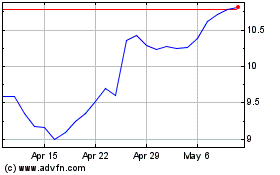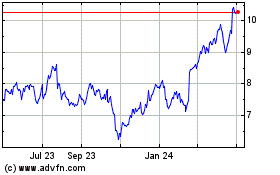Barclays CEO's Penalties Over Whistleblower Saga Top $1.5 Million -- 2nd Update
May 11 2018 - 8:55AM
Dow Jones News
By Max Colchester
LONDON -- Barclays PLC Chief Executive Jes Staley has been hit
with penalties equal to roughly a quarter of his 2016 pay over his
efforts to unmask a whistleblower.
After a yearlong probe, U.K. regulators Friday fined the
American executive GBP642,430 ($868,501) for a "serious error of
judgment" in trying to identify the author of a letter that made
criticisms of a hire Barclays made, but ultimately said Mr. Staley
could keep his job.
The British bank's board also Friday docked pay worth GBP500,000
from Mr. Staley's 2016 bonus. In total that year, he earned GBP4.23
million.
"I have consistently acknowledged that my personal involvement
in this matter was inappropriate, and I have apologized for
mistakes which I made," Mr. Staley said in a statement.
The episode, which has proved an embarrassing distraction for
Mr. Staley, shows how British regulators looked to balance the risk
of destabilizing Barclays by forcing a CEO change with the need to
show they take protecting the identity of whistleblowers seriously.
Complicating matters was the fact that Mr. Staley's actions
occurred just before new U.K. rules came into force to protect not
just whistleblowers within a company but anyone who privately flags
concerns of bad behavior.
According to the account filed by the Financial Conduct
Authority, in June 2016 a member of the Barclays board received a
letter from a person identifying themselves as "John Q. Public," a
long-term shareholder in Barclays. The letter addressed issues
around Barclays's hiring of Mr. Staley's former JPMorgan Chase
& Co. colleague Tim Main, according to people familiar with the
matter. The letter made personal allegations about Mr. Main. It
also questioned the process for hiring him at Barclays, the FCA
said.
Mr. Staley told regulators he considered that the letter's
sender didn't count as a whistleblower because, among other things,
the person was from outside Barclays. Mr. Staley emailed a copy of
the letter to a friend and former colleague of Mr. Main and
discussed creating a support network for him if the letter became
public.
Later that month, Barclays's office in New York received a
second letter expressing similar concerns. The letter was anonymous
but was purported to have been drafted by Barclays employees,
according to the FCA. "This raised in Mr. Staley's mind the need to
find a way to stop this campaign by finding out who was sending the
Letters, proving that they weren't whistleblows and that their
contents were false," the regulator said. The FCA said Mr. Staley
failed to recognize that both the letters could have been written
by insiders at Barclays and so whistleblowing rules needed to
apply.
In late June, Mr. Staley asked security to identify the author
of the first letter. The security team at Barclays told colleagues
in the U.S. they would need to examine the letter and envelope to
identify the author. A day later, Mr. Staley met with Barclays's
general counsel and head of compliance and was told "it was
generally not a good idea to try to identify the author of an
anonymous letter" and that they could be considered whistleblowers.
The executive took this advice and the process to identify the
author was called off.
A month later, Mr. Staley asked his office for an update on the
matter and was again told the letters were being treated as
whistleblows. Mr. Staley and his office said they didn't recall
whether he was told this.
The day after, Mr. Staley spoke to compliance and again was told
the author of the letter couldn't be identified. Mr. Staley said he
couldn't remember the contents of the call and mistakenly
understood that compliance told him that the letter was no longer
being treated as a whistleblow, in part because the allegations
around the hiring process were unfounded. Without informing
compliance, the board or executive committee members, Mr. Staley
told the security team that he had been given clearance to find the
author of the first letter.
Mr. Staley later sent a text message to the security team asking
for an update on the attempt to identify the author of the letter.
He received a response saying the security team wanted to get video
footage of the purchase of the postage for the letter from U.S.
contacts. This proved impossible and Mr. Staley then asked if he
could contact the author of the letter another way. He was told
no.
In early 2017, Barclays's board was told of Mr. Staley's attempt
to identify the author of the letter. The board began its own probe
and told regulators.
"Given his conflict Mr. Staley should have maintained an
appropriate distance; he should not have taken steps to identify
the author," the regulators wrote in a joint statement.
Write to Max Colchester at max.colchester@wsj.com
(END) Dow Jones Newswires
May 11, 2018 08:40 ET (12:40 GMT)
Copyright (c) 2018 Dow Jones & Company, Inc.
Barclays (NYSE:BCS)
Historical Stock Chart
From Mar 2024 to Apr 2024

Barclays (NYSE:BCS)
Historical Stock Chart
From Apr 2023 to Apr 2024
